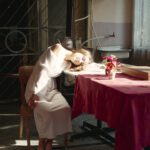Chloé Sassi, France – Photography/Performance
Chloé Sassi is born in 1996 in Ithaca, United States. She has grown up in France, with an early interest in the field of arts. She graduated in 2017 in Fines Arts at the Villa Arson, south of France. She lives and works between Berlin and Nice, travelling frequently looking for ruins.
Mainly interested in photography and videos, Sassi also makes performances as collective experiences or « human scenography ». She is exploring the idea of rituals and « transitional spaces », playing with the perception of time and the notion of gender. Always searching for an « other side space » in order to provoke the « arising of new situations in reality », she is also working around the perspective of a Total Art, which would like to summon all human senses to immerse the viewer in an unicity of a global ambience.
“Revolution”
Statement:
Beyond the idea of the repudiation of a political system, the word “Revolution” also defines a movement in or as if in circle, and one complete turn in such motions. In this way, we could see all our History like an infinite loop, coming back and back again to the same points – as a ritual. Levi Strauss considered that History can be divided in two states : usually the political life flows gently in the “Cold History”, without major disruption, and revolutions correspond to the moment of changes, the “Hot History”.
I tried to build this video like a metaphor of this concept, considering life as “a theater”. The cold history correspond to a frozen time, made as a suspended picture, a living painting. A first fist breaks immobility and revolution appears like a dance – until the fall. And from the fall, a new rise, and from this rise a new fall: a perpetual loop. This project have been made with the participation of the young people of Gorna Lipnitsa.
“Offerings”
Statement:
But no revolution without death. My other video “Offerings” depicts the importance of honoring the dead in the Bulgarian culture. Made as a performance, the video (in old dv quality) shows the ritual of giving life to an imaginary pagan alter ego through a bread mask. This alter ego makes a procession in the cemetery of the village, distributing flowers on the graves, feeding the dead with life.








